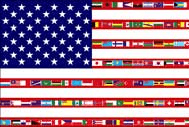Fact: Diaspora’s in the United States send about $48 billion a year to their home countries in remittances. That is almost double what the United States spends in official development assistance. One of the key questions at a first of its kind meeting of Diaspora communities at the State Department this week is how to capture those remittances for long term development–not just short term consumption.
But money is only part of the equation–migrants in the United States often have technical skills that are needed in their home countries. They also often have the will and wherewithall to lend their skills to development projects in the their home countries. One of the key questions is how to tap into these skilled migrants to promote long term economic development of their home countries.
These questions–and several others–were discussed in detail this afternoon at a breakout panel of the Secretary’s Diaspora Forum. The panel, sponsored by the UN Foundation, focused on how grassroots engagement is bringing together diaspora communities to tackle major global issues. Aaron Sherinian, Executive Director of Communications for the UN Foudation moderated, Maria Teresa Kumar, Co-Founder, Voto Latino; Eric Farnsworth, Vice President, Americas Society/Council of the Americas; TMS (Teddy) Ruge, co-founder, Project Diaspora; Elizabeth Warn, Specialist in Labor Migration and Development, International Organization for Migration were on hand to offer remarks.
There will be video of the event soon, but for now here are some highlights/quotes/pearls of wisdom from the participants:
Teddy Ruge:
“Development in Africa is a combination of three things: Diaspora, technology and youth pressures.”
“If it works in Africa, it works everywhere else. If you can prove your case in Africa, you can prove your case anywhere else.”
RE the MDGs: “You cannot solve a global problem in an office. You have to be on the ground.”
Elizabeth Warn
One specific challenge is where you think about diapsora engagement in fragile states. Perhaps the state is too weak and lacks resources to engage diaspora. The IOM is working with OECD to look at ways diasporas might be able to contribute to institution building. “IOM helps identify needs in weak governments [and match those needs] with the skills of the diaspora.”
Maria Teresa Kumar
By the numbers, the third largest Latino country in the World is the USA. Just behind Brazil and Mexico in the number of Latinos in the country.
What happens when remittances run dry?
Eric Farnsworth
Mexico receives $22 billion in remittances. That makes it the second highest source of national income after oil exports. The aim should be to capitalize on remittances for long term development, not just short term consumption.
Diasporas can sometime drive policy on their home country. Cuba is a good example of a Diaspora community that has successfully organized around a policy–whether or not you agree with the policy, the Cuba diaspora has very strongly influenced U.S. Cuba policy for decades.
